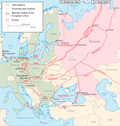| Baltic Pipeline System | |
|---|---|
 Location of Baltic Pipeline System | |
| Location | |
| Country | Russia |
| General direction | south-north-west |
| From | Yaroslavl |
| Passes through | Kirishi |
| To | Primorsk |
| Runs alongside | Sever Pipeline |
| General information | |
| Type | Oil |
| Operator | Transneft |
| Commissioned | 2001 |
| Technical information | |
| Maximum discharge | 76.5 million tons per year |
The Baltic Pipeline System (BPS) is a Russian oil transport system operated by the oil pipeline company Transneft. The BPS transports oil from the Timan-Pechora region, West Siberia and Urals-Volga regions to Primorsk oil terminal at the eastern part of the Gulf of Finland.
